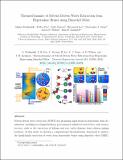Notice
This is not the latest version of this item. The latest version can be found at:https://dspace.mit.edu/handle/1721.1/139796.2
Thermodynamics of solvent-driven water extraction from hypersaline brines using dimethyl ether
| dc.contributor.author | Deshmukh, Akshay | |
| dc.contributor.author | Foo, Zi Hao | |
| dc.contributor.author | Stetson, Caleb | |
| dc.contributor.author | Lee, Hyeonseok | |
| dc.contributor.author | Orme, Christopher J. | |
| dc.contributor.author | Wilson, Aaron D. | |
| dc.contributor.author | Lienhard, John H. | |
| dc.date.accessioned | 2022-01-31T15:57:19Z | |
| dc.date.available | 2022-01-31T15:57:19Z | |
| dc.date.issued | 2022-04 | |
| dc.identifier.issn | 1385-8947 | |
| dc.identifier.uri | https://hdl.handle.net/1721.1/139796 | |
| dc.description.abstract | Solvent-driven water extraction (SDWE) has promising applications in hypersaline brine desalination, including zero-liquid discharge processing for industrial wastewaters, and resource recovery, such as the extraction of lithium and rare earth elements from solution mining leachates. In this study, we develop a computational thermodynamic framework to analyze the liquid–liquid extraction of water from hypersaline brines using dimethyl ether (DME), an aprotic solvent that is partially miscible with water. The high volatility of DME enables its rapid separation from water–DME mixtures after water absorption, while its low polarity minimizes the organic-phase solubility of electrolytes, such as sodium chloride (NaCl). We first build a thermodynamic model based on the LIQUAC excess Gibbs free energy model for water–DME–NaCl mixtures. Maximum likelihood estimators for water–DME–NaCl interaction parameters are calculated through the nonlinear regression of fluid phase equilibrium and osmotic coefficient data using metaheuristic global optimization techniques. A multistage counter-current liquid–liquid separator (LLS) model is then developed to explore the water recovery and brine concentration ratios achievable as a function of feed molality and DME to feed water flow rate ratio. For a saline feed with a molality of (over three times the salinity of seawater) our analysis demonstrates that a one-stage LLS can achieve a water recovery ratio of 0.51 with an initial DME to saline feed molar flow rate ratio of 4.0, rising to 0.63 with a second equilibrium stage. We conclude by quantifying the amount of DME required to reach zero-liquid discharge brine salinities and analyzing the impact of staging and temperature on separation performance. Our thermodynamic model enables the rapid evaluation of SDWE systems for emerging hypersaline brine desalination and valorization applications. | en_US |
| dc.publisher | Elsevier BV | en_US |
| dc.relation.isversionof | 10.1016/j.cej.2021.134391 | en_US |
| dc.rights | Creative Commons Attribution-Noncommercial-Share Alike | en_US |
| dc.rights.uri | http://creativecommons.org/licenses/by-nc-sa/4.0/ | en_US |
| dc.source | Prof. Lienhard | en_US |
| dc.title | Thermodynamics of solvent-driven water extraction from hypersaline brines using dimethyl ether | en_US |
| dc.type | Article | en_US |
| dc.identifier.citation | Deshmukh, Akshay, Foo, Zi Hao, Stetson, Caleb, Lee, Hyeonseok, Orme, Christopher J. et al. 2022. "Thermodynamics of solvent-driven water extraction from hypersaline brines using dimethyl ether." Chemical Engineering Journal, 434. | |
| dc.relation.journal | Chemical Engineering Journal | en_US |
| dc.eprint.version | Author's final manuscript | en_US |
| dc.type.uri | http://purl.org/eprint/type/JournalArticle | en_US |
| eprint.status | http://purl.org/eprint/status/PeerReviewed | en_US |
| dspace.date.submission | 2022-01-31T15:54:30Z | |
| mit.journal.volume | 434 | en_US |
| mit.license | OPEN_ACCESS_POLICY | |
| mit.metadata.status | Authority Work and Publication Information Needed | en_US |
